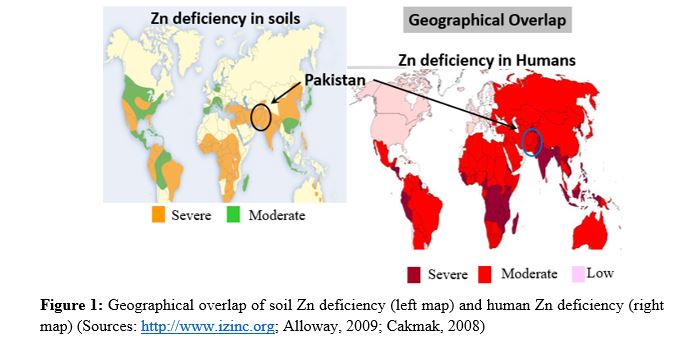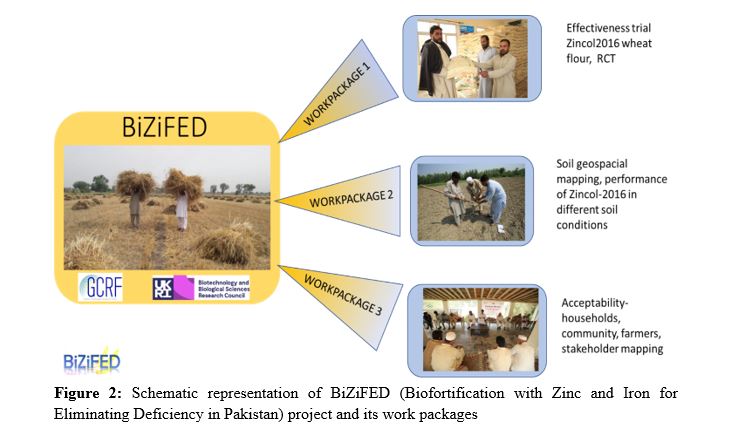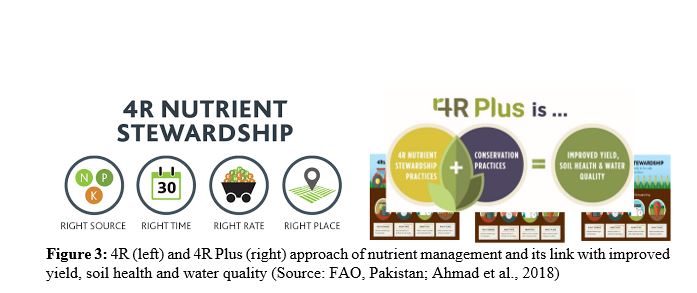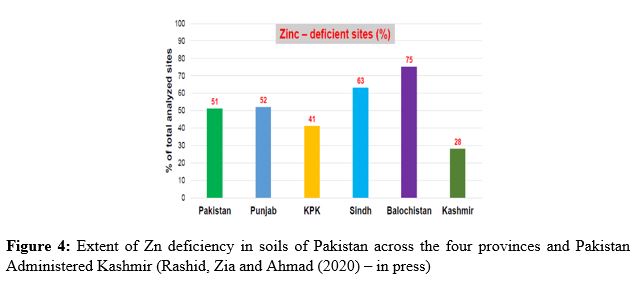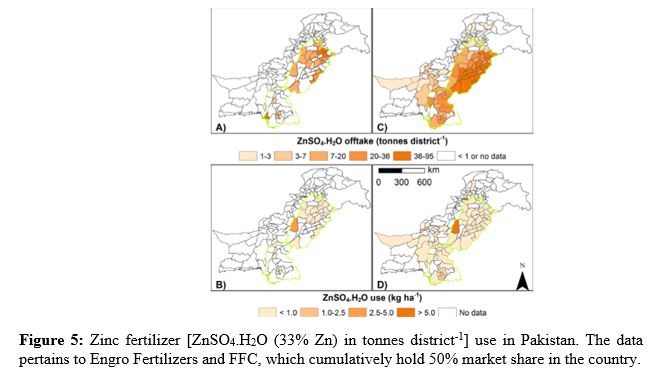PAS Agriculture webinar episode 6 entitled “Valuing Zinc Nutrition for better Crop Production & Human Health/Policy Brief”
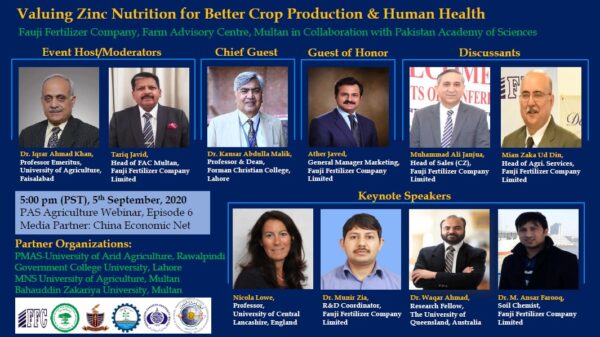
PAS Agriculture Policy Debate, Episode # 6
Prof. Dr. Iqrar A. Khan in collaboration with Pakistan Academy of Sciences (PAS), Fauji Fertilizer Company (FFC), Farm Advisory Centre, Multan, PMAS-University of Arid Agriculture, Rawalpindi, Government College University, Lahore, MNS-University of Agriculture, Multan and Bahauddin Zakariya University, Multan organized a zoom PAS Agriculture webinar episode 6 entitled “Valuing Zinc Nutrition for Better Crop Production and Human Health” on 05th, September 2020 at 05:00 PM PST.
Executive Summary
Malnutrition leads to stunting, wasting and obesity. The malnourished population is a multiple burden on the economy as a health cost and wasted opportunities. Reliable estimates (UNDP 2017) suggest that up to 60% of the population is suffering from some sort of malnutrition. The worst hit are anemic women and children. Among the categories of malnutrition, we have calorie deficit for the extreme poor, protein deficiency among a significant proportion of low-income groups and vitamin and mineral deficiencies across the income classes.
Dietary Zn deficiency is a global problem, affecting 17% of the world’s population, with the greatest burden in low-income and middle-income countries due to poverty. The symptoms and effects of Zn deficiency are manifested in many forms and serious medical and social conditions. The element is required in trace amounts which is not storable in the human body. Thus, it is an element that must be consumed as a part of daily diet. People with a habit of-and access to diverse diet including meat, fish and dairy products can easily meet their daily dietary Zn requirements. However, a large segment of our population eats wheat bread as the major daily diet with no or little access to animal protein.
In Pakistan, Zn deficiency affects over 40% of the adult female population, resulting in suboptimal immune status and increased likelihood of complications during pregnancy. About 18.6% children under the age of 5 years are reported to be severely Zn deficient in Pakistan (NNS, 2018). Zn deficiency in soils has been recognized as the major cause of Zn malnutrition in humans. According to soil micronutrient samples analyzed by FFC laboratories indicate 85% of the soils of Pakistan are Zn deficient. Low soil supply of Zn to edible cereal grains is subsequently translated into human Zn malnutrition problem. Therefore, concerted efforts at various scales are urgently needed to address the growing deficiency of Zn in soils of Pakistan, its impact on crop productivity and subsequent impact on human health. In this context, Pakistan Academy of Science (PAS) in collaboration with Fauji Fertilizer Company (FFC), Farm Advisory Center, Multan organized a webinar on the theme “Valuing Zinc Nutrition for Better Crop Production and Human Health”. Dr. Iqrar Ahmad Khan and Mr. Tariq Javid were the event moderators. The meeting was attended by 162 participants from 5 countries, logged in for two hours in the session chaired by Dr. Kauser Abdulla Malik, former Chairman PARC, former Member Food Security, Planning Commission of Pakistan, and former Member Administration & Biosciences, Pakistan Atomic Energy Commission.
As a summary of the event, following pathways were identified as strategic policy outline for improving the Zn contents of wheat as major staple in Pakistan:
- Zn is a critical trace element for human health which should be consumed as a part of daily diet. Zn deficiency is rampant in our population and more so in women and children. People eating diverse diet including red meat and fish are considered safe. But, a large proportion of our population lives below the poverty line where balanced diet is a remote possibility.
- Food chain approach is the best solution to correct a deficiency whereby daily diets should contain minimum required amounts of trace elements in the staple food. There is a land-water-plants-man continuum that should contain the essential elements of human diet. It is known that our staple crops are deficient in Zn and as a result the eatables are also Zn deficient.
- One of the causes of deficiency is ‘dilution’ affect that has occurred due to exponential increases in crop yields of staple crops (wheat, rice, maize) that has thinned out availability and uptake of Zn in the body of plant. The intensive cropping systems have also depleted the soils of trace elements. The fertilizer applications are limited to three macro elements which are also responsible for disproportionate depletion of micronutrients from the soils.
- Soil and foliar Zn applications are recommended as a corrective measure which will not only improve the plant uptake but also allow for transfer of trace elements including Zn to the consumer of plant products.
- Wheat and rice being the principle staple food have to be biofortified with excess Zn. In case of wheat, a variety named ZINCOL has been released by CIMMYT and Harvest Plus is promoting this variety. This variety has genetic potentials to accumulate significantly higher quantities of Zn in the grain to meet human requirements. Clinical trial has provided strong evidence in favor of using ZINCOL variety in the diets.
- The socio-economic benefit to the society of Zn application and cultivation of high zinc absorbing varieties is evident. But there is very little evidence of yield benefits to the farmer. That makes a good case for a public subsidy to promote Zn application to staple food crops.
Opening Remarks/Welcome Address
Dr. Iqrar Ahmad Khan, Professor Emeritus, University of Agriculture, Faisalabad opened the virtual meeting by thanking participants and presented an overview of meetings’ agenda (see Annex A), consisting of presentations to introduce topics of discussion including discovery of Zn essentiality for human, magnitude of Zn deficiency in soils and cereal crops and its vital linkage to human health, and finding a sustainable solution to Zn deficiency – update from BiZiFED project.
Mr. Muhammad Ali Janjua, Head of Sales (Central Zone), FFC presented an overview of company profile and its marketing operations. He explained the company’s resolve to promote Zn enriched wheat production as a Corporate Social Responsibility (CSR). FFC being a fertilizer giant, has all the means and skill to address this national cause, he emphasized in the presentation.
Keynote Presentations:
Zn Nutrition: From Discovery to Human Health Impacts – Pak Perspective
Dr. Muhammad Ansar Farooq, Soil Chemist, FFC discussed the history and discovery of Zn essentiality for living organisms. Zinc always has been a significant mineral element for plants, animals as well as human beings. However, realization of this significance initially developed slowly. The first indication about Zn essentiality appeared in 1869 when Raulin, a student of Louis Pasteur, reported that Zn was a required nutrient for the growth of Aspergillus niger, a fungus that causes black mold in some agricultural produce, including grapes, onions, and peanuts (Raulin, 1869). The remarkable finding remained dormant until 1914, when Zn was reported essential for growth and development of maize (Mazé, 1914). Although by 1960, the essentiality of Zn for growth in various higher plants (Sommer and Lipman, 1926) and animal species (Todd and Elvehjem, 1934; O’Dell, 1958) was reported, it was considered improbable that Zn deficiency in humans could lead to significant clinical problems. Essentiality of Zn for humans and its deficiency was recognized in 1963 (Prasad et al., 1961; 1963).
During the past 5 decades, it has become apparent that deficiency of Zn in humans is prevalent. Nutritional deficiency of Zn may affect nearly 2 billion people in the developing world. Zinc is involved in many biochemical functions. Over 300 enzymes require Zn for their activation and nearly 2000 transcription factors require Zn for gene expression (Prasad, 2012). Zinc is essential for cell mediated immunity. Zinc is also an effective antioxidant and anti-inflammatory agent. Oxidative stress and chronic inflammation are important contributing factors in several chronic diseases. Data suggest that Zn may have a protective effect in some chronic diseases where oxidative stress and chronic inflammation are involved (Prasad, 2014). Dr. Ansar Farooq shared a similar empirical evidence from his Ph.D. thesis, where Cd-induced oxidative stress was reported to activate members of rice Stress Associated Proteins (SAPs) family viz. SAP1 and SAP14 at transcript level (Farooq et al., 2016). Protein sequence analysis of SAPs revealed multiple Cys- and His- residues in their A20/AN1 zinc-finger domains binding Zn that is released upon oxidation and proteins undergo redox-dependent conformational changes. Further, in vivo analysis using FRET and X-Gal assay revealed their interaction with CML49 (a calcium binding protein), thereby indicating rice SAP/CML49 module work at the crossroad of redox- and Ca2+-signalling and help rice to tolerate Cd-induced oxidative stress (Farooq et al., 2016; 2019). He suggested that Zn may have a similar protective effect in some human chronic diseases where oxidative stress and chronic inflammation are involved.
Zn deficiency in soils has now been recognized as the major cause of Zn malnutrition in humans. In this context, soil micronutrient samples analyzed by FFC laboratories indicate 85% of the soils of Pakistan are Zn deficient that consequently impact growth and development processes in higher plants. Likewise, low soil supply of Zn to edible cereal grains has subsequently translated into human Zn malnutrition problem. A close geographical overlap is observed between the global distribution of soil and human Zn deficiency, which tells that inadequate Zn supply through the food chain is hampering human health (Figure 1) (Cakmak, 2008). This relatively recent realization about the pivotal role of low micronutrient content staple cereals as a cause of micronutrient malnutrition in developing countries of the world calls for better attention to adequate micronutrient nutrition of crop plants (Graham and Welch, 2000).
Towards a Sustainable Solution to Zn Deficiency: the BiZiFED Project
Dr. Nicola Lowe, Professor, University of Central Lancashire, UK made an elaborate presentation on BiZiFED project (Figure 2) that is designed to evaluate the potential of Biofortified wheat (Zincol-2016) on Zn dietary intake in a resource-poor setting community in Khyber Pakhtunkhwa, Pakistan (Lowe et al., 2018). According to National Nutrition Survey carried out by Planning Commission, Govt. of Pakistan (NNS, 2018), Zn deficiency is prevalent in 40% women across the country (O’Dell and Savage, 1960), thereby causing profound consequences ranging from increased individual morbidity and mortality to problems with community and regional economic development (Prasad, 1961). Several strategies have been devised to eradicate Zn malnutrition across the globe as well as Pakistan. (i) Use of Zn supplementation has been attempted under various circumstances, however with little success (Prasad et al., 1963). Nevertheless, it is regarded as intensive but expensive approach, and without close supervision it can often be that the intended target, for example a pregnant woman, does not end up receiving the supplement. (ii) Fortification of food commodities at the processing stage has also been widely adopted, but faced problems of poor compliance and efficacy e.g. ineffective quality control at the fortification stage as well as uptake by the local population etc. Likewise, poor rural communities in developing countries have huge dependency on self-grown food and process it at village or community level. Thus, cereal fortification at large-scale processing facilities may not reach poorer households, where micronutrient deficiencies are often more prevalent and severe. (iii) Biofortification of staple food crops renders a sustainable and cost-effective approach to fight micronutrient malnutrition in resource poor settings with low dietary diversity (Sandstead et al., 1967). This can be achieved either through crop breeding or application of micronutrient-enriched fertilizers, commonly known as “agronomic biofortification”, particularly in countries like Pakistan having low plant-available soil Zn contents (Halsted et al., 1972). In Pakistan, Zn-deficient soils that constitute 52% at national scale are also prevalent in Peshawar, KPK, where plant-available soil Zn contents are significantly below the threshold of 1mg/kg in 41% of the soils analyzed. Farmers in Pakistan rarely apply Zn fertilizers to their crops except for rice. Biofortification approaches have focused on staple crops because they are widely consumed including households with low purchasing power. Recently, HarvestPlus developed varieties of beans, maize and pearl millet with high Zn and iron (Fe) contents have been released for deployment in low-income settings (MacMahon et al., 1968; Hambidge et al., 1972). Subsequent human feeding trials have demonstrated that such varieties can lead to improvements in Zn and Fe intake and status, although there might be issues with low bioavailability (Barnes and Moynahan, 1973).
In a recent set of experiments within the HarvestPlus program over a period of 8 years, scientists in Pakistan using traditional breeding techniques have been able to generate a ‘high Zn’ variety of wheat that is adapted to Pakistan conditions. The variety (Zincol-2016/NR-421) contains more Zn per kilogram of grain compared with traditional varieties e.g. Galaxy (Kay and Tasman-Jones, 1975). However, grain Zn contents also depend on the soil Zn status, and there are likely to be synergistic effects of breeding for high Zn with application of Zn fertilizers. She presented data on the field work at the farmer fields and explained a series of trials being conducted in KPK. The pilot project was funded by the Office of Research Innovation and Commercialization Khyber Medical University. Zincol-NR421 grain was supplied by HarvestPlus, and grown by Fauji Fertilizer Company. Recent pilot trials of feeding “Zincol” derived whole-wheat flour in Pakistan have confirmed significant improvement in human plasma Zn concentration i.e. from 680 µg L−1 to 794 µg L−1 however, to validate the results, further feeding trials are ongoing under BiZiFED2 project using a large set of population (Khan et al., 2017; Lowe et al., 2018). The BiZiFED team is also engaging with stakeholders and policymakers to disseminate findings as they become available.
4Rs in Crop Production with Emphasis on Micronutrient
Dr. Waqar Ahmad, Research Fellow, The University of Queensland presented his work pertaining 4Rs in crop production with emphasis on micronutrients. The principles for effective use of any fertilizer (including micronutrient fertilizers) are to select the right source of nutrients, applied at the right rate, at the right time, and right place (Figure 3). These four rights (4Rs) of nutrient stewardship, principally developed by International Plant Nutrition Institute (IPNI); International Fertilizer Industry Association (IFA); Canadian Fertilizer Institute (CFI) and The Fertilizer Institute (TFI) indicate a strong interrelation among these four factors and if any one of these is compromised, the whole approach has to be reconsidered (Bruulsema et al., 2012; Norton and Roberts, 2012). The 4R approach to Nutrient management is regarded as an integral component of the best management practices (BMPs), and also linked with various aspects of agricultural production systems. Right source, matches nutrient type to crop needs; Right rate, matches the quantity of nutrients to the crop needs and depends on soil and water analyses, crop and soil fertility status; Right time, involves making nutrients available when the crop needs them and is correlated with crop-responsive growth stages; Right place, encompasses keeping nutrients where crops can use them and is associated with using the best method which shows higher nutrient use efficiency and/or minimal loss (Figure 3).
To promote the concept of 4Rs, two projects were funded by USDA/FAO-UN that were implemented in all of the four provinces of Pakistan. To highlight the importance of these two projects, he discussed the ‘High Ripple Effect’ that helped to distinguish it from the general concept of ‘Balanced Fertilizer Application’, considering only Right source & Right rate. Successful implementation advantages of 4Rs projects were perceived in the form of more funds allocation by private sectors to establish new SWTL, inclusion of commodity-specific 4Rs in literature by the National Fertilizer Companies, as well as encouraging academia to include special case studies in syllabus. Furthermore, four ‘Soil Atlases’ were developed from the two projects that provide a comprehensive account for (i) Soil fertility status (District-wise); (ii) Soil classification data; (iii) Native best management practices; (iv) Fertilizer use trends and respective yields at farm-gate; (v) Management strategy for resource-based improvement; (vi) Key messages for farming community.
After the successful implementation of the above projects, the new concept of ‘4R Plus’ is now introduced that encompasses the 4R nutrient stewardship plus conservation practices (Figure 3). The aim of 4R Plus is to improve yield, soil health and water quality. Furthermore, it also included the ‘Nutritional aspect’ in the broader sense, giving it a more weightage than the Food Security. To support his argument of enhanced significance of nutritional security over food security, he discussed it in the context of the 2030 Agenda for Sustainable Development and the United Nations Decade of Action on Nutrition (2016-2025), requiring all countries and stakeholders to act together to end hunger and prevent all forms of malnutrition by 2030. Hence, achieving nutritious food production for all has become the greatest challenge ever faced by the humanity. Herein, he discussed the magnitude of micronutrient(s) deficiencies in soils, crops, as well as their cost-effective management strategies. To this end, the earlier reports regarded soil Zn deficiency as the most important micronutrient problem in the country, Nevertheless, post-1998 research re-affirmed that deficiencies of economic significance are primarily limited to Zn, B, and Fe and their subsequent impact on human health at the soil-plant-human nexus. Talking about the need for Zn nutrition of crops in the context of 4Rs package, he discussed the cost-effective management of soil Zn deficiency in wheat, rice and maize crops.
Soil-Grain-Human Transfer of Zinc (BiZiFED Project)
Dr. Munir Zia, R&D coordinator, FFC discussed soil-grain-human transfer of Zn in the context of update from BiZiFED project. While talking about causes of Zn deficiency in soils and cereals across the country, he said that post-1960s Green Revolution, the exponential increase in crop yields of staple crops (wheat, rice, maize) has caused a ‘dilution effect’ on micronutrient(s) concentration in grains. Furthermore, the intensive cropping systems have also depleted the soils of trace elements. According to literature, Zn deficiency in soils of Pakistan (particularly in Baluchistan and Sindh provinces) is widespread and ~50% soils are Zn deficient across the country (Figure 4).
On the other hand, there is considerable variation in Zn fertilizer use across the country, with negligible application in most of the Districts except in rice growing belt and D.G. Khan district of southern Punjab (Figure 5). Considering its agronomic perspective (grain yield harvest/kg Zn application) as well as economic perspective (VCR), it is highly desirable to include Zn fertilization of crops as part of 4Rs nutrient stewardship. Residual effect of soil Zn application has also been reported for subsequent 4-6 crops, however, Zn application to rice crop is recommended every year due to its increased competition with other micronutrients like Fe under submerged conditions. From the health perspective, full adoption of Zn fertilizer for wheat has been estimated to provide additional annual return of 405-1216 million International Dollars (I$) in Punjab, alone.
While talking about baseline and progress of Pakistan in the context of SDGs, he expressed his concerns over the report of National Nutrition Survey conducted by Planning Commission of Pakistan (NNS, 2018), indicating significant improvement in population Zn status. He said that in recent times, public awareness about the serious gravity of micronutrient malnutrition has increased to some extent. But there is contradiction in data about stunting in children of <5 years age (an important indicator of human Zn status & its health consequences), persistence of negative trend (-4.29) is contradictory to the survey data of improvement in population Zn status that needs to be re-evaluated.
Update from BiZiFED project, he stated that right from its inception during the early 2000s, Pakistan is an active partner in the HarvestPlus global program for enriching staple crop produce with micronutrients. Though the mandate of HarvestPlus includes a wide array of staple crops, including wheat and rice and micronutrients (i.e., Zn, Fe, I, vitamin A, etc.), Pakistan was assigned to work on wheat enrichment with Zn only. The efforts, so far, have resulted in the development of five Zn-efficient wheat lines (HarvestPlus, 2014). One of the many high-Zn wheat lines under test in Pakistan, only “Zincol-2016” has been approved till-to-date as a variety by the Punjab Seed Council, Government of Punjab, Pakistan. Whereas average concentration of Zn in Pakistani wheat varieties is around 25.0 mg kg-1 (average of 75 locations across Pakistan), the high-Zn wheat variety “Zincol-2016” developed by National Agriculture Research System with the financial support of HarvestPlus contains around 37 mg Zn kg-1 (average of 12 locations across the country). To measure Zn uptake potential of Zincol-2016, replicated field trials are underway using soils with contrasted Zn (DTPA-extractable) status. The preliminary results show a good performance of Zincol-2016 under Zn-rich soils only, while it did not perform under low Zn soils. Therefore, he made a case for foliar application as well as using Zinc coated Urea fertilizer to get the desired results. To evaluate the potential nutritional impact of Zn-biofortified crops it is important to understand how varietal performance is influenced by environmental factors, including soil type and crop management. In this context, WP2 of BiZiFED project is in progress pertinent to influence of farm practices and soil geochemistry on Zincol-2016 performance.
Panel Discussion
Dr. Asif Kamran raised the issue of economic viability and pointed out that the Zn biofortification should either result in higher productivity to cover the additional costs to the producers or the consumers should pay a higher price for the biofortified harvest. In case the consumers are not willing to pay the higher price due to lack of knowledge about the associated health benefits and affordability constraints and producers are not willing to adopt the intervention due to profitability concerns, the public policy prescription supporting subsidies is justified based on societal benefits anticipated form saved Disability Adjusted Life Years (DALYs) per unit of cost of subsidy paid in form of price premium or subsidized Zn supplemented agrochemicals (fertilizers, pesticides, and fungicides etc.). Dr. Asghar argued that foliar spray of Zn is not an effective method for large acreages. However, it is known that foliar spray allows sufficient uptake of Zn in tree crops. A correlation between salinity and Zn and other micro-nutrients was also highlighted. Dr. Kauser Abdulla Malik closed the session by thanking the moderators (PAS & FFC) for arranging a very useful virtual meeting on Zn nutrition that is equally important for the health of plants as well as human beings. While sharing his work experience on micronutrients during the last three decades, he acknowledged the significance of micronutrients (particularly Zn & Fe) for crop health and emphasized to make sure that all wheat & rice varieties identified as Zn efficient must also be tested for their bioavailability for human beings. In this context, high phytate contents of cereals has been a major issue that bind micronutrients in the lower intestine, thereby reducing their bioavailability for human nutrition. Therefore, research efforts dedicated to micronutrient nutrition for crop and human health must consider all such factors.
References
Ahmad, M., S. Alam, W. Ahmad, I. Jan, and A. Zia. 2018. Application of the 4R nutrient stewardship concept for growing off-season tomatoes in high tunnels. J. Soil Sci. Plant Nutr. 18(4): 989-1001.
Alloway, B.J. 2009. Soil factors associated with zinc deficiency in crops and humans. Environ. Geochem. Health. 31:537-548.
Barnes, P.M. and E.J. Moynahan. 1973. Zinc deficiency in acrodermatitis enteropathica. Proc. R. Soc. Med. 66: 327–9.
Bruulsema, T.W., F. Garcia, and T. Satyanaryana. 2012. The 4R nutrient stewardship concept. In: 4R Plant Nutrition a Manual for Improving the Management of Plant Nutrition Metric Version. International Plant Nutrition Institute, Norcross, USA. p. 21–27.
Cakmak, I. 2008. Zinc deficiency in wheat in Turkey. In: B.J. Alloway (Ed.), Micronutrient Deficiencies in Global Crop Production, p. 181–200. Springer, Dordrecht, The Netherlands.
Graham, R.D., and R.M. Welch. 2000. Plant food micronutrient composition and human nutrition. Commun. Soil Sci. Plant Anal. 31: 1627-1640.
Halsted, J.A., H.A. Ronaghy, P. Abadi, G.H. Haghshenass, Amirhakimi, R.M. Barakat, et al. 1972. Zinc deficiency in man: The Shiraz experiment. Am. J. Med. 53: 277–84.
Hambidge, K.M., C. Hambidge, M. Jacobs, and J.D. Brown. 1972. Low levels of zinc in hair, anorexia, poor growth and hypogeusia in children. Pediatr. Res. 6: 868–74.
HarvestPlus. 2014. Biofortification Progress Briefs. Accessible at www.HarvestPlus.org. (Accessed on Feb 23, 2019).
Farooq, M.A., A.K. Niazi, J. Akhtar, Saifullah, M. Farooq, Z. Souri, N. Karimi, and Z. Rengel. 2019. Acquiring control: The evolution of ROS-induced oxidative stress and redox signaling pathways in plant stress responses. Plant Physiol. Biochem. 141: 353–369.
Farooq, M.A., A. Detterbeck, S. Clemens, and K.-J. Dietz. 2016. Silicon-induced reversibility of cadmium toxicity in rice. J. Exp. Bot. 67(11): 3573–3585.
Kay, R.G. and C. Tasman-Jones. 1975. Zinc deficiency and intravenous feeding. Lancet 2: 605–6.
Khan, M., U. Ullah, M. Usama, M. Broadley, M. Afridi, M.H. Zia, H. McArdle, S. Young, and N. Lowe. 2017. Effect of agronomically-biofortified zinc flour on zinc and selenium status in resource poor settings: a randomized control pilot trial. Presented at The Nutrition Society Summer Conference 2017: Improving nutrition in metropolitan areas, 10-12 July, 2017, London, UK.
Lowe, N.M., M.J. Khan, M.R. Broadley, M.H. Zia, H.J. McArdle, E.J.M. Joy, H. Ohly, B. Shahzad, U. Ullah, G. Kabana, R. Medhi, and M.Z. Afridi. 2018. Examining the effectiveness of consuming flour made from agronomically biofortified wheat (Zincol-2016/NR-421) for improving Zn status in women in a low-resource setting in Pakistan: study protocol for a randomised, double-blind, controlled cross-over trial (BiZiFED). The BMJ. 10.1136/bmjopen-2017-021364.
MacMahon, R.A., M.L. Parker and M. McKinnon. 1968. Zinc treatment in malabsorption. Med. J. Aust. 2: 210–2.
Mazé, P. 1914. Influences respective des elements de la solution minérale sur le development du mais. Ann Inst Pasteur (Paris). 28: 21–68.
National Nutrition Survey (NNS). 2018. Key Findings Report. Ministry of National Health Services, Regulation and Coordination, Government of Pakistan, Islamabad, 52 pp.
Norton, R.M., and T. Roberts. 2012. Nutrient management to nutrient stewardship. In: Capturing Opportunities and Overcoming Obstacles in Australian Agronomy. Ed. I. Yunusa. Proc. 16th Aust. Agron. Conf. 2012.
O’Dell, B.L. and J.E. Savage. 1960. Effect of phytic acid on zinc bioavailability. Proc. Soc. Exp. Biol. Med. 103: 304–6.
O’Dell, B.L., P.M. Newberne, and J.E. Savage. 1958. Significance of dietary zinc for the growing chicken. J. Nutr. 65:503–18.
Prasad, A.S. 2014. Zinc is an Antioxidant and Anti-Inflammatory Agent: Its Role in Human Health. Front. Nutr. 1–14.
Prasad, A.S. 2012. Discovery of human Zinc deficiency: 50 years later. J. Trace Elem. Med. Biol. 26: 66–69.
Prasad, A.S., A. Miale, Z. Farid, A. Schulert, and H.H. Sandstead. 1963. Zinc metabolism in patients with the syndrome of iron deficiency anemia; hypogonadism and dwarfism. J. Lab. Clin. Med. 61: 537–49.
Prasad, A.S., J.A. Halsted, and M. Nadimi. 1961. Syndrome of iron deficiency anemia, hepatosplenomegaly, hypogonadism, dwarfism, and geophagia. Am. J. Med. 31: 532–46.
Raulin, J. 1869. Chemical studies on vegetation [in French]. Ann. Sci. Nat. 11: 93–9.
Sandstead, H.H., A.S. Prasad, A.R. Schulert, Z. Farid, A. Miale Jr, S. Bassily, et al. 1967. Human zinc deficiency, endocrine manifestations and response to treatment. Am. J. Clin. Nutr. 20: 422–42.
Sommer, A.L. and C.B. Lipman. 1926. Evidence on the indispensable nature of zinc and boron for higher green plants. Plant Physiol. 1: 231–49.
Todd, W.R., C.A. Elvehjem, and E.B. Hart. 1933. Zinc in the nutrition of the rat. Am. J. Physiol. 107: 146–56.
Acknowledgements
- Pakistan Academy of Sciences
- Fauji Fertilizer Company Limited
- University of Central Lancashire, UK
- The University of Queensland, Australia
- Government College University, Lahore
- PMAS Arid Agriculture University, Rawalpindi
- MNS University of Agriculture, Multan
- Bahauddin Zakariya University, Multan
- FAO-UN PAKISTAN, ROME
- Pakistan Agricultural Research Council
- United States Department of Agriculture
- United States Agency for International Development
- National Fertilizer Development Centre
- Research, Development, Extension and Information Wings
Web services were provided by Mr. Shehzad Ashraf and Mr. Muhammad Naseer. Webinar design, illustrations, announcements, registration, feedback and analysis, and editorial assistance by Mr. Nehal Ahmad Khan.
Supplementary Information
The audio/video recording of the event is available at the webpage of PAS www.paspk.org and at the YouTube link: https://youtu.be/0QsJ1zZHnHM

